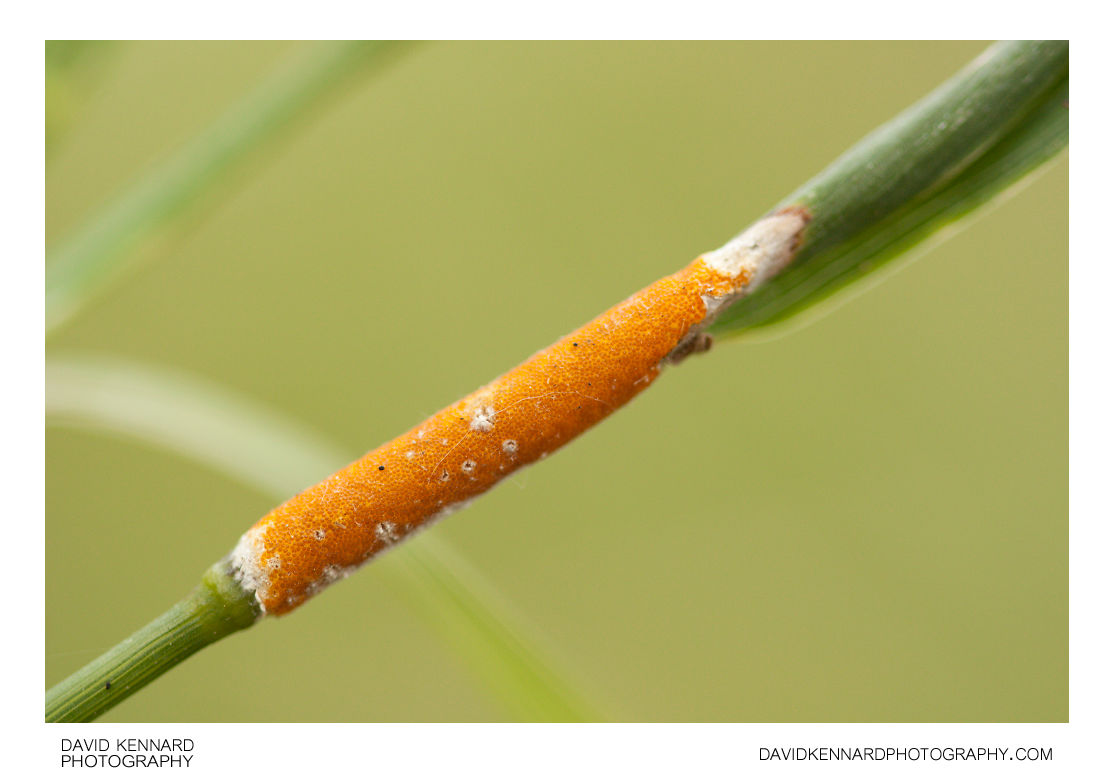Epichloë sp. fungus on grass

Description
- Title:
- Epichloë sp. fungus on grass
- Caption / Description:
-
Epichloë species and their close relatives, the Neotyphodium species, are systemic and constitutive symbionts of cool-season grasses (Poaceae subfamily Pooideae), and belong to the fungal family Clavicipitaceae. Among the Clavicipitaceae, many species are specialized to form and maintain systemic, constitutive (long-term) symbioses with plants, often with limited or no disease incurred on the host.
The best-studied of these symbionts are associated with the grasses and sedges, in which they infect the leaves and other aerial tissues by growing between the plant cells (endophytic growth) or on the surface above or beneath the cuticle (epiphytic growth). An individual infected plant will generally bear only a single genetic individual clavicipitaceous symbiont, so the plant-fungus system constitutes a genetic unit called a symbiotum (pl. symbiota).
Symptoms and signs of the fungal infection, if manifested at all, only occur on a specific tissue or site of the host tiller, where the fungal stroma or sclerotium emerges. The stroma (pl. stromata) is a mycelial cushion that gives rise first to asexual spores (conidia), then to the sexual fruiting bodies (ascocarps; perithecia). Sclerotia are hard resting structures that later (after incubation on the ground) germinate to form stipate stromata.
Depending on the fungus species, the host tissues on which stromata or sclerotia are produced may be young inflorescences and surrounding leaves, individual florets, nodes, or small segments of the leaves. Young stromata are hyaline (colorless), and as they mature they turn dark gray, black, or yellow-orange. Mature stromata eject meiotically derived spores (ascospores), which are ejected into the atmosphere and initiate new plant infections (horizontal transmission).
In some cases no stroma or sclerotium is produced, but the fungus infects seeds produced by the infected plant, and is thereby transmitted vertically to the next host generation. Most Epichloë species and all of their asexual derivatives, the Neotyphodium species, can vertically transmit.
Neotyphodium species (with the likely exception of N. chilense) are closely related to teleomorphic species of the genus Epichloë, from which many have evolved by processes involving interspecific hybridization. Molecular phylogenetic evidence demonstrates that asexual Neotyphodium species are derived either from individual Epichloë species, or more commonly, from hybrids with at least two ancestral Epichloë species.
Like the Neotyphodium species, many species in Epichloë produce biologically active alkaloids, such as ergot alkaloids, indole-diterpenoids (e.g. lolitrem B), loline alkaloids, and the unusual guanidinium alkaloid, peramine.
Because of their close relationships and shared biological properties, members of these two genera are collectively called epichloae (singular = epichloë).
Description taken from Wikipedia: http://en.wikipedia.org/wiki/Epichlo%C3%AB
- Tags / Keywords:
-
- Biota
- Life
- Vitae
- Eukaryota
- Grass
- Fungi
- Epichloë
- Ascomycota
- Sac fungi
- Sordariomycetes
- Pyrenomycetes
- Hypocreales
- Clavicipitaceae
Admin
- Date Original Photo Taken:
- Original File Name:
- _MG_8484.CR2
- Event:
- Rating:
- ☆
- Date this image added/last updated on website:
- Original File Dimensions:
- 4272px x 2848px
- File Type:
- JPEG
- Color Mode:
- Original Image Color Profile:
- Adobe RGB (1998)
Location
- Location Created:
-
- Sublocation:
- City:
- Marston Trussell
- Province/State:
- Northamptonshire
- Country:
- United Kingdom
- World Region:
- Europe
- Geo-location:
- 52.474896666667, -0.94991666666667 View on map
Rights
- Copyright Status:
- Copyrighted
- Licensing Status:
- Rights Managed
- Available for Editorial Use:
- Yes
- Available for Commercial Use:
- Yes
- Copyright Notice:
- © 2011 Dave Kennard
Camera Data
- Date Digital Resource was created:
- Shutter speed:
- 1⁄160 s
- Aperture:
- f/2.8
- Camera Model:
- Canon EOS 450D
- ISO:
- 400
- Exposure Compensation:
- 0
- Focal Length:
- 100mm
- Focal Length (35mm equiv.):
- Metering Mode:
- Center-weighted average
- Flash:
- Off, Did not fire
- Exposure Mode:
- Manual
- White Balance:
- Manual
- Light Source:
- Exposure Program:
- Manual
Additional shooting metadata
- Lens:
- Canon EF 100mm F2.8 Macro USM
- Filters used:
- Additional Optics used:
- Setup:
- Handheld
Liveview using Hoodeye LCD viewfinder
Post Processing
- Image Modified:
- Software used:
-
- Adobe Camera RAW
- Post Processing:
